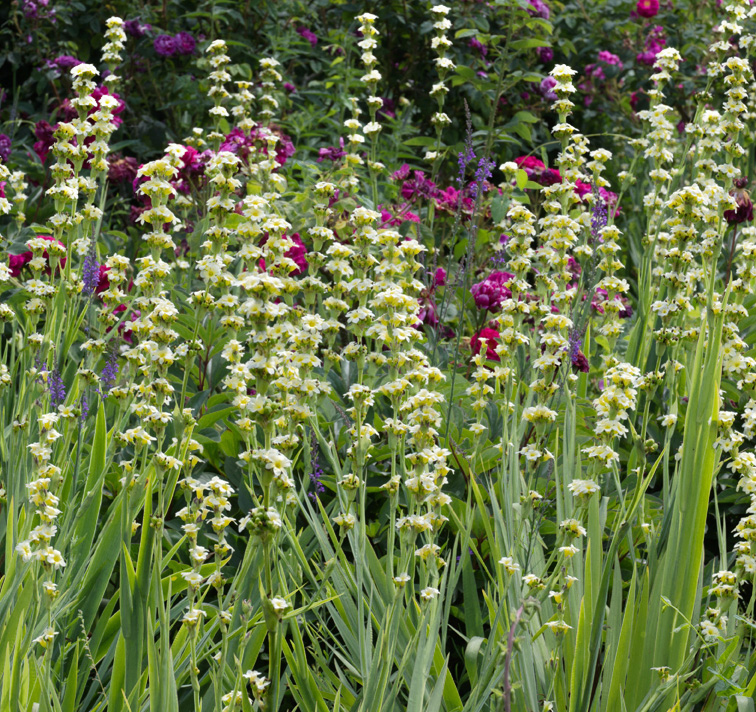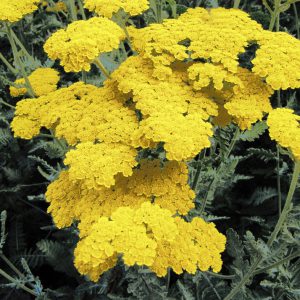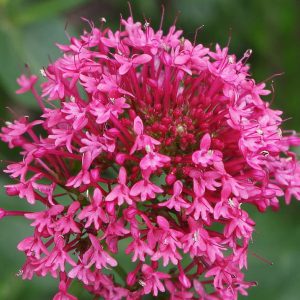- 1-9 pkts $4.50
- 10 pkts FREE
- Express post $12
Sisyrinchium striatum
SATIN FLOWER
I find Sisyrinchium striatum one of the most useful plants for all the challenging spots in my garden.
Tough as old boots but very handsome
Sisyrinchium striatum is a handsome, decorative plant – so we are lucky it is also so darned tough.
Handsome structure of foliage fans
Fans of Iris-like foliage form great structure in the garden all year round.
Giving firm fan shapes as a contrast to looser plants in the garden design.
Leaves are also sage-green gray which again gives good colour contrast.
Foliage clumps stand approx. 45cm. high x 30cm. wide at the top of the fan.
Lemon satin stars in early summer
Then in late spring and summer multiple spires rise above each foliage fan, studded with lots of little lemon star flowers.
With a beautiful satin sheen to the petals, and delicate lavender pencil stripes on the petal backs.
Flower spires are approx. 70-80cm. tall and show well above the foliage fans.
Satin Flower really is a handsome plant worthy of any prominent position, or anywhere you need it’s tough ability to grow.
Bone tough & hardy in sun or shade
Sisyrinchium striatum is a member of the Iris family from Argentina and Chile.
So it is well acquainted with hot and dry; sun or shade; and cold frosty winters.
While it flowers more profusely in ample sun, it still does an attractive flowering job even in quite a lot of shade.
And the foliage fans are attractive everywhere.
I use it along a driveway under big old trees, where the soil is hungry and water deprived.
Water-wise & heat hardy
Plants of Sisyrinchium striatum are well able to cope with minimal watering, once they are established. They give striking structure to any dry garden planting.
And they will rot out in consistently moist or wet soil.
Do not over-water.
Tolerates poor soil well
Poor and infertile soils, sandy, gravel and stony soils, do not daunt Satin Flowers – they grow well.
And in fact they should not be planted in soil that is too rich or overfertilized, though average garden loam is fine.
As long as the soil is well drained they are easily pleased.
Satin flowers enjoy a neutral to slightly alkaline soil pH best, though they also cope in acid soils.
Pest & disease resistant
Nothing seems to eat or disease Sisyrinchium striatum.
They are virtually pest and disease free, and we have never had them touched by rabbits, possums or our other munching enemies. They seem to favour more lush fodder.
Low maintenance – minimal work
Sisyrinchium stiatum is an excellent choice for a low-maintenance garden.
They require little to nothing in the way of extra watering or fertilizing.
The only annual task is to cut the whole clump back after flowering, just as you do an Iris, to tidy up for the year ahead. The clump will quickly be back with it’s handsome foliage fans.
Bees buzz for the star blooms
The lemon stars buzz with native and honey bees during the spring and summer blooming season. There is a constant procession of star blooms – so Sisyrinchium is an asset to our pollinators too.
SEED SOWING ADVICE: QUICK & EASY
Seeds of Sisyrinchium striatum are easy to germinate.
Sow at any time indoors in punnets, whenever suitable temperatures can be provided.
OR
Scatter directly in garden in autumn for spring germination.
Sow indoors for quicker and maximum germination: First sow the seeds in a punnet on the surface of good quality seed raising mix.
Then just lightly sprinkle the seeds with sieved mix or fine vermiculite, but do not bury deeply.
Because these seeds need light to germinate.
Now thoroughly moisten the punnet by standing it in a shallow water bath.
And allowing the moisture to percolate up to the surface of the mix from below.
Now drain and place the punnet in a warm, well-lit position (with good light but no direct sunlight).
Temperatures of 10-20°C approx. are ideal for rapid and optimum germination.
Continue to keep the punnet moist by misting the punnet from a spray water bottle.
Covering the punnet with a clear plastic cover will help to maintain necessary consistent moisture.
These seeds really respond to consistent moisture levels, without being wet, or drying out completely.
Seeds germinate in 3-4 weeks.
But do not discard the punnet too quickly, as seeds will continue to germinate over a period. Which is normal for Sisyrinchium striatum.
Once the seedlings have developed their first true leaves, prick out of the punnet into small pots and grow on until planting out into the garden.
Seed Count: 20 seeds per pack approx.
(We always aim to exceed the stated seed count, and give a generous serve).
Click here for Nursery Open Days & Open Gardens Information
https://www.gardivalia.com.au/open-gardens
Click here to go back to Seeds Shop
https://www.seedscape.net.au/shop/
Related products
-
Add to WishlistAlready In WishlistAdd to Wishlist
-
Add to WishlistAlready In WishlistAdd to Wishlist
-
Add to WishlistAlready In WishlistAdd to Wishlist
-
Add to WishlistAlready In WishlistAdd to Wishlist





